Abstract
Coordinating the relationship between water use and industrial ecosystem development is the key to ensuring high-quality and sustainable development of the industrial economy. In this paper, a model was proposed for evaluating and predicting the coordination between water use and industrial ecosystem development. First, aiming at the coordination of water use and industrial ecosystem development, this paper determined 15 indicators from the aspects of water demand and supply, water conservation and environmental protection, industrial sustainable development, input and output, and industrial development status. The combination weighting method based on game theory was used to determine the weight of the evaluation index. Then, the coordination evaluation model called the back propagation neural network (BP)–coupling coordination degree model (CCDM) and the coordination prediction model called gray models (GM)–BP–CCDM were established. Finally, the model was applied to the coordination evaluation and prediction of water use and industrial ecosystem development in the Hebei Province, China. The results show that the coordination degree of cities in the Hebei Province is moderate. Therefore, based on the research results, some scientific and reasonable suggestions for water resources utilization and industrial ecosystem development were put forward.
1. Introduction
Water resources are one of the essential resources for human survival, and the natural resources on which industrial and economic development depends. As one of the world’s major economic powers, the industrial development of China is inseparable from the extensive utilization of water resources. However, in the process of industrial development, the contradiction between the supply and demand of industrial water, serious water pollution, and other problems have resulted in an extremely mismatched and uncoordinated phenomenon in the process of water use and industrial development in China.
With the shortage of water resources becoming a global concern, water resources management has been a hot topic for many scholars. Argyris Panagopoulos argued that the sustainable use of water resources can be achieved through brine management [1]. Ober, J. et al. discussed various activities related to water resource management and analyzed the evaluation of selected quality parameters of tap water in Poland and Ukraine [2]. Dolan, F. et al. evaluated the economic impact of water scarcity in a changing world [3]. Shindhal, T. discussed the most advanced technological and scientific developments in wastewater treatment in the dye industry [4]. Ostad-Ali-Askari, K. et al. argued that consideration of water quality and quantity issues is necessary for the sustainable management of water resources [5]. Jasechko, S. et al. argued that water from groundwater wells can run dry when water tables decline [6]. Zhengtong Li et al. researched various solar technologies for alternative water use in response to the global water crisis [7].
Many scholars have conducted research on the coordination of water resources utilization and industrial structure [8,9]. The main coordination evaluation models and methods used include the coupling coordination degree model [10,11], gray relation and coupling coordination degree model [12], set pair analysis method [13], ecological niche model [14], gray relational degree model [15], water resource ecological footprint model [16], gray relational entropy evaluation method [17], information entropy [18], etc. Some scholars have researched the relationship between secondary industry and water resources utilization. Hu Zhenyun et al. [19] studied the dynamic adjustment of Xinjiang’s industrial structure underwater resource constraints. Jiang Guiqin et al. [20] established a simple coordination evaluation method to validate the coordination of industrial development and water use in the Anhui Province. Zhang Xiaojun et al. [21] studied the adjustment of the secondary industry in Beijing under the constraints of water resources. Guo Jiahang et al. [22] studied the relationship between water use and the development of the secondary industry in Xinjiang.
The industrial ecosystem is a modern industrial development pattern characterized by resource conservation and environmental protection. It is an organic system composed of three subsystems: society, economy, and environment. Many scholars have conducted research on industrial ecosystems [23,24]. Some scholars mainly focused on the diversity of industrial ecosystems [25], the internal control and stability mechanisms of the system [26], and stability evaluation [27]. Shrestha, R. argued for the need to remove and/or recover these toxic, non-biodegradable, and persistent heavy metals from industrial wastewater [28]. Tsujimoto, M. argued that the concept of ecosystems is becoming increasingly important in the field of technology and innovation management [29]. Benitez, G.B. argued that innovation ecosystems allow SMEs to integrate resources and co-create Industry 4.0 solutions [30].
In China, industry is the foundation of the national economy, and its water use problem is the most prominent in agriculture, industry, and services [31]. By studying the problems of water use and the development of industrial ecosystems, regional water use will transition into low consumption and low pollution, and promote the transformation and upgrading of regional industries. The findings will be of interest to those engaged in solving the prominent problems of water use in the process of industrial development and the sustainable development of industrial industry.
Compared with the existing research, the innovation of this paper is reflected in the following aspects: first, from the perspective of industrial water use and industrial ecosystem development, an evaluation index system for the degree of coordination was established. Second, the coupling coordination evaluation model was enriched. The combination weighting method was used for determining the weight of evaluation indicators, and the back propagation neural network evaluation method was adopted for the comprehensive evaluation model. It can not only process a large amount of data quickly and correctly, but also combine the gray prediction model to predict the coordination degree of various cities in Hebei Province. Third, it analyzes the coordination of industrial water use and industrial ecosystem development in various cities in Hebei Province. Some relevant suggestions for the coordinated development of industrial water and industrial ecosystem were put forward. The research results can provide a reference for local government planning.
2. Methods
2.1. Object of Study
Hebei Province is located in northern China and around Beijing, the political, economic, and cultural center of China. Its geographical location is very important. There are 11 cities in Hebei Province, including Tangshan, Langfang, Shijiazhuang, Baoding, Qinhuangdao, Xingtai, Hengshui, Cangzhou, Zhangjiakou, Handan, and Chengde. There is a serious shortage of water resources in Hebei Province, and the space–time distribution of water resources is uneven. The problem of water pollution is serious, and the demand for water is huge. The contradiction between water supply and water demand is more and more obvious. Therefore, taking 11 cities in Hebei Province as the research objects, this paper studies the coordination between water use and the development of industrial ecosystems in each city in the last 10 years (2011–2020), and forecasts the situation of each city in 2025.
2.2. Coordinated Evaluation Index System
The evaluation index is one of the indispensable elements in the process of systematic evaluation, and the rationality of its selection is directly related to the accuracy of evaluation results. The principles of scientific nature, comparability, representativeness, and systematization should be considered in establishing a coordinated evaluation index system. Considering that industrial water resource utilization has a prominent contradiction between supply and demand and serious water pollution, we have selected seven evaluation indicators to evaluate water use from three aspects of water demand, supply and conservation, and environmental protection. The basis of industrial development is the need for a certain amount of human, material, and financial input, and industrial output is the basis for measuring industrial development. In addition, the green and sustainable development of industry also needs to be considered. Therefore, we selected eight evaluation indicators to evaluate the development of the industrial ecosystem from the four aspects of industrial sustainable development, input, output, and development status. Regarding the nature of the indicators, except for the six indicators under industrial water demand and sustainable development, which are negative indicators, the rest of the indicators are positive indicators. The specific evaluation index system is shown in Figure 1.
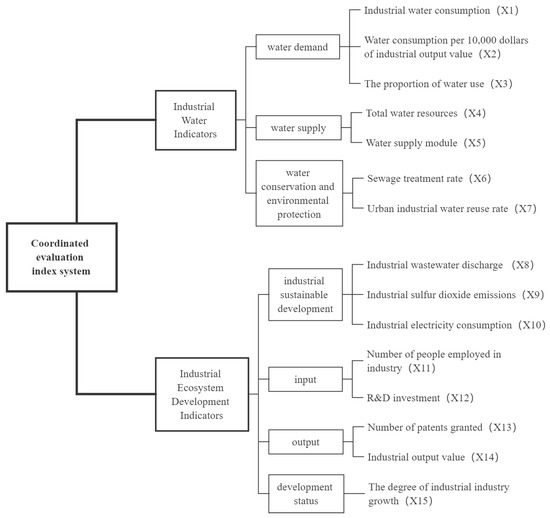
Figure 1.
Coordinated evaluation index system.
The index of the growth degree of the industrial industry is measured by the elasticity coefficient of the growth of the industrial industry. The calculation method is expressed as follows:
Therefore, based on the growth degree of each evaluation object industrial industry, and consulting the opinions of relevant experts in this research field, the scoring standards were established as shown in Table 1.

Table 1.
Industrial industry growth degree scoring standard.
2.3. Coordinated Evaluation Model
To calculate the coupling coordination value of water use and industrial ecosystem development, the coordinated evaluation model is established. Firstly, the combination weighting method combining subjective weighting and objective weighting is adopted to determine the weight of each evaluation index. Then, take the sum of the product of each evaluation index value and the corresponding weight as the expected output value of the back propagation neural network, train the back propagation neural network evaluation model, and bring in the relevant index values to obtain the comprehensive score value. Finally, the coupling coordination model of water use and industrial ecosystem development is established, and the coupling coordination scheduling of each evaluation object is calculated. The model was called BP–CCDM.
2.3.1. Combination Weighting Method Based on Game Theory
The subjective weight of each evaluation index is obtained by constructing the judgment matrix and carrying out the consistency test. The weight obtained by the AHP is recorded as .
The AHP method divides complex problems into structures with multiple layers, such as the object layer, index layer, and subindex layer [32]. The structure diagram of the AHP hierarchical network is shown in Figure 2. Index layers and subindex layers include multiple evaluation factors. In pairwise comparisons, a number from 1 to 9 and its reciprocal are used to indicate the relative importance of assessing the factors. The relative importance of the assessment factors is used to establish a consistent judgment matrix. Finally, mathematical theory is applied to calculate the vector corresponding to the maximum eigenvalue of the matrix. Relevant literature was used to determine the weight of AHP methods in evaluation indicators [33,34,35].
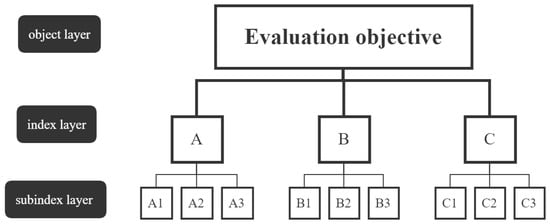
Figure 2.
The structure diagram of the AHP hierarchical network.
The objective weight of the evaluation index is obtained by calculating the coefficient of variation of each evaluation index referring to a related study [36]. The specific formula is expressed as follows:
where:
- -
- is the coefficient of variation for item i;
- -
- represents the standard deviation of item i;
- -
- represents the mean value of item i;
- -
- represents the number of evaluation indicators;
- -
- is the objective weight for item i.
The combination weighting method based on game theory is used to determine the comprehensive weights. There are several weighting methods, and each weighting method has a corresponding weight set. Then, the linear combination of all weighting methods is shown below referring to a related study [37].
where:
- -
- is the optimized combination of coefficients;
- -
- represents a set of weights for each weighting method;
- -
- represents the number of weighting methods.
Taking the minimization of the dispersion of w and as the goal, the strategy model is obtained as follows:
The optimal first derivative condition of the above equation can be transformed into the following equations:
The method of normalizing the calculated optimal combination coefficients is as follows:
Finally, the optimized combination weight obtained by the game theory combination weighting method is as follows:
2.3.2. Back Propagation Neural Network Evaluation Model
Back propagation networks are multi-layer feed-forward neural networks that can implement arbitrary non-linear mapping from input to output. A typical back propagation network is a model consisting of three levels of neurons: an input layer, an output layer, and an intermediate hidden layer [38].
This paper required obtaining two comprehensive score values for water use and industrial ecosystem development, to design back propagation neural network models for training. The establishment process of the back propagation neural network evaluation model mainly includes back propagation neural network structure design, model parameter determination, model training and testing, and model application. The specific content of establishing the back propagation neural network evaluation model is shown in Table 2.

Table 2.
Back propagation neural network evaluation model.
2.3.3. Coupling Coordination Degree Model
On the basis of the training of the back propagation neural network evaluation model, the obtained comprehensive scores of water use and industrial ecosystem development are recorded as α and β, respectively, and then a coupling coordination degree model is established to evaluate the coordination of water use and industrial ecosystem development.
where:
- -
- is the degree of coupling;
- -
- represents the coupling degree of coordination.
In terms of the coordination grade division of water use and industrial ecosystem development, referring to many studies [10,11,18] on coordination evaluation and considering the characteristics of the coordination evaluation of water use and industrial ecosystem development, this paper divides the coupling coordination degree of water use and industrial ecosystem development into eight grades. The degree is divided into eight grades, and the specific grades are shown in Table 3.

Table 3.
Coupling coordination degree classification.
2.4. Coordination Prediction Model
In order to obtain the predicted value of the coupling coordination degree of water use and industrial ecosystem development, this paper establishes a coordinated prediction model for water use and industrial ecosystem development based on the GM–BP–CCDM model. The specific prediction model steps are as follows.
First, establish the GM(1,1) gray prediction model to predict the future value of each evaluation index. Accumulate data from the original sequence to obtain a new data sequence. The calculation method of a single datum in the new sequence is as follows:
where:
- -
- is the original data sequence;
- -
- represents the new data series;
- -
- represents the number of data.
A first-order linear differential equation for is established as follows:
where:
- -
- is the development coefficient;
- -
- represents the gray effect.
Then, solve the gray parameters, and the method is as follows:
where:
- -
- is the matrix obtained by averaging the accumulated data;
- -
- represents the constant term vector.
Bring the gray parameters into the differential equation to solve, and the results are as follows:
Discrete and differentiate and in order to restore the data sequence, and obtain an approximate predicted data sequence as follows:
Then, the established gray model is tested, and the relative error, variance ratio, and small error probability are calculated. If the accuracy of the model meets the requirements, a prediction can be made.
Finally, bring the predicted values into the previously established coordination evaluation model of water use and industrial ecosystem development based on the BP–CCDM model, and calculate the predicted value of the coupling coordination degree of each evaluation object.
3. Results
3.1. Coordination Evaluation Results
In this paper, the subjective and objective weights of the evaluation indicators are obtained by using the AHP subjective weighting and the objective weighting method of the coefficient of variation method. The combination weighting method based on game theory is used to obtain the final weights. The subjective and objective weights and combination weights of the evaluation indicators are shown in Figure 3.
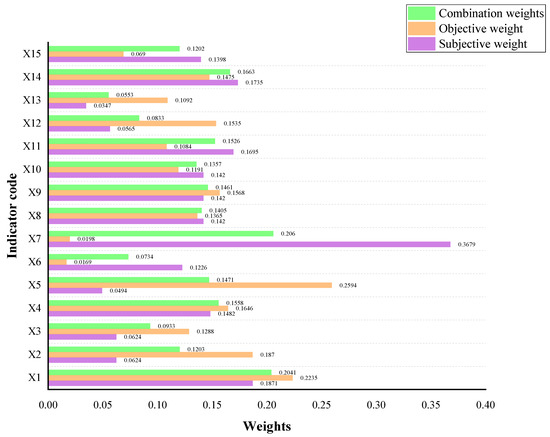
Figure 3.
The weight of the evaluation indicator.
Firstly, establish the back propagation neural network evaluation model. A total of 88 samples are randomly selected as the training set, and the remaining 22 samples are the test set. Then, calculate the maximum relative error between the actual output value and the expected output value of the test sample, and obtain the maximum relative errors of the water use and industrial ecosystem development evaluation models that are 1.07% and 3.84%, respectively, meeting the accuracy requirement of 5% maximum relative error, which proves that the back propagation neural network model has been trained well. Finally, the comprehensive score of water use and industrial ecosystem development of each assessment object is calculated. The comprehensive scores of water use and industrial ecosystem development are shown in Figure 4 and Figure 5, respectively.
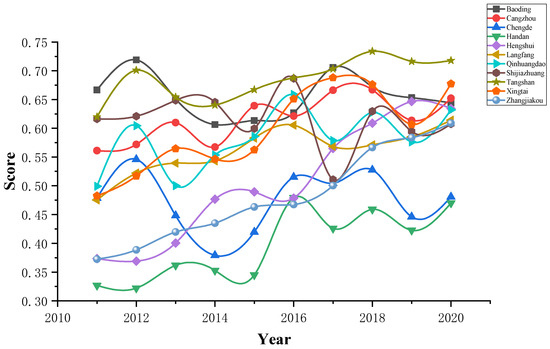
Figure 4.
Comprehensive score value of water use.
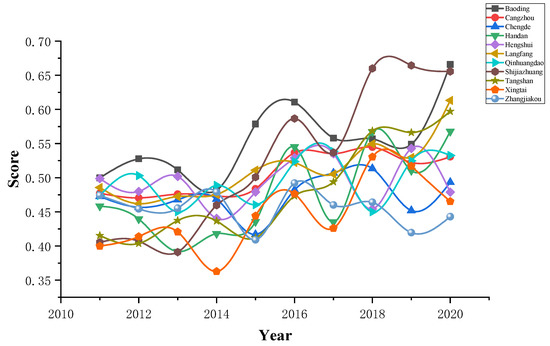
Figure 5.
Comprehensive score for industrial ecosystem development.
Substitute the comprehensive score value of water use and industrial ecosystem development into the coupling coordination model, and obtain the coupling coordination degree of each evaluation object, as shown in Figure 6.
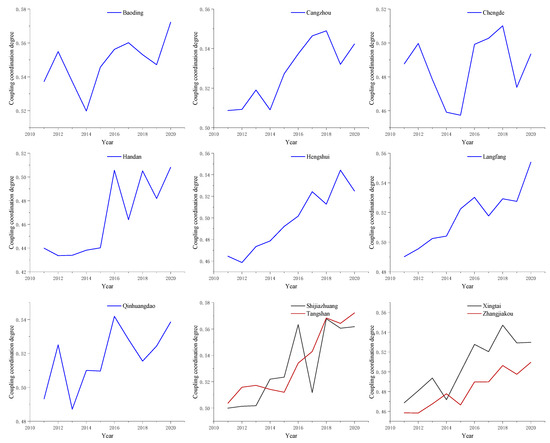
Figure 6.
Coupling coordination degree values from 2011 to 2020.
3.2. Coordination Prediction Results
The gray prediction model is used to calculate the prediction value of each evaluation index in 2025, and the predicted value is substituted into the BP–CCDM model. Finally, the coupling coordination degree of each city in 2025 is obtained, as shown in Figure 7.
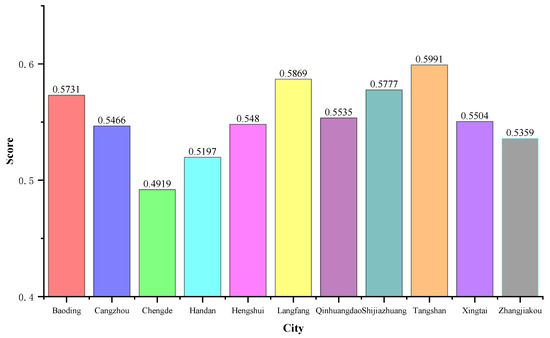
Figure 7.
Coordination prediction results for 2025.
4. Discussion
The research results show that the coordination degree between water use and industrial development in various cities of Hebei Province was greatly improved in 2016 compared with 2015. In 2016, the pilot reform of the water resources tax was carried out in Hebei Province, which shows that the reform of the water resources tax has played a certain role in improving the coordination between water use and industrial development in Hebei Province. However, in the years following 2016, the coordination degree of some cities showed a certain degree of fluctuation, which also showed that certain problems were exposed in the water resource tax reform. The reform of the water resources tax is of great significance for enterprises and society with regard to saving water resources and achieving the sustainable development of water resources. Therefore, problems must be found, and solutions must be formulated in time during the reform of the water resources tax. In fact, many problems were exposed after the implementation of the water tax reform in Hebei Province. First, it has caused the problem of increasing the tax burden on urban water supply and public water supply units. Second, there is the problem that it is difficult to collect and manage unlicensed water enterprises. Finally, the price structure of the terminal water supply needs to be adjusted. The emergence of these problems has led to a fluctuating trend in the coordination degree of various cities in Hebei Province after 2016. Particularly, many cities showed a downward trend in 2019. Therefore, in order to improve the coordination degree of cities, the further optimization of water tax reform is one of the key next steps.
According to the coordinated evaluation results of water use and industrial ecosystem development in Hebei Province from 2011 to 2020, it can be seen from the time dimension that the coupling coordination degree of each city has shown a trend of fluctuation and rising over the years, and the range of change is not large. The coupling coordination degree of each city is between 0.4 and 0.6. The coupling coordination degree is on the verge of imbalance or barely coordinated. From the perspective of spatial dimension, except Chengde City, where the coupling coordination degree is fluctuating, the coupling coordination degree of other cities shows an overall upward trend. Baoding, Cangzhou, Langfang, Shijiazhuang, and Tangshan City have a relatively good coupling coordination degree, which is at a barely coordinated degree, while other cities are at a near imbalance or barely coordinated degree. Baoding, Cangzhou, Shijiazhuang, and Tangshan City have better performance in water use, while Baoding Langfang, Shijiazhuang, and Tangshan have performed well in the development of industrial ecosystems. It can be seen that the improvement in coupling coordination degree must be caused by the simultaneous increase in the scores of water use and industrial development, or the increase on one side and the fluctuation trend on the other side.
According to the coordinated forecast results of water use and industrial ecosystem development in Hebei Province, the coupling coordination degree of each city has not changed much compared with 2011–2020. Except for Chengde, which is on the verge of imbalance, other cities have reached a barely coordinated degree. As shown in Figure 8, compared with the start year (2011), the coupling and coordination degree of each city in the forecast year (2025) has improved, and the maximum growth rate of Langfang City is 0.0967. By 2025, the order of coupling coordination degrees of cities from high to low will be Tangshan, Langfang, Shijiazhuang, Baoding, Qinhuangdao, Xingtai, Hengshui, Cangzhou, Zhangjiakou, Handan, and Chengde.
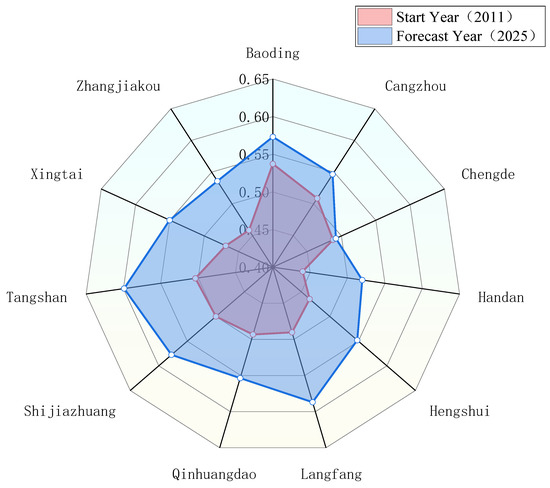
Figure 8.
Comparison of coupling coordination degrees between 2011 and 2025.
In order to further improve the coordination degree of water use and industrial ecosystem development in various cities, this paper puts forward the following suggestions: From the perspective of water use, the strictest water resource management system should be implemented, and a rigid water resource constraint system should be established. Enterprises that fail to meet the sewage discharge standards should be severely punished, and water-saving actions should be implemented to further control water consumption. At the same time, it is necessary to improve the reuse rate of water resources. From the perspective of industrial ecosystem development, it is necessary to increase the investment in R&D and manufacturing, to encourage innovation to improve the core competitiveness and independent controllability of enterprises, and ultimately achieve high-quality development of industrial enterprises. At the same time, it is necessary to achieve sustainable development and reduce the discharge of wastewater and waste gas. We should also save energy, and the goal is to achieve the green development of industrial enterprises.
5. Conclusions
In this paper, the BP–CCDM model provided a complete solution system for the coordinated evaluation of water use and industrial ecosystem development. The GM–BP–CCDM model was established for coordinated evaluation and prediction, which not only ensured the reliability of the evaluation results, but also improved the accuracy of the prediction results. In addition, the model established in this paper can also be used to study other parts of China. This approach can provide solutions to areas with the same problems.
Therefore, the main conclusions of the current study are the following:
First, the coordinated development degree of water use and industrial ecosystem development in various cities was on the verge of imbalance or barely coordinated, and the coupling coordination degree was in a state of slow growth.
Second, according to the results of the coordination evaluation, the coordination degree of cities in Hebei Province in 2016 showed a significant improvement trend compared with 2015, and the coupling coordination degree of some cities showed fluctuations after 2016.
Third, in order to further improve the coordination between industrial water use and industrial ecosystem development in Hebei Province, the government department must take certain measures.
The selection of evaluation indicators is not perfect. When constructing the evaluation index system of industrial water and industrial development in Hebei Province, there were too few relevant indicators selected due to the difficulty of obtaining relevant data materials. In the future, more indicators could be selected for study when the statistics are more complete.
Author Contributions
All authors contributed to the study conception and design. Data collection was performed by H.Z. and Y.Z. Analysis was performed by L.Z. The first draft of the manuscript was written by J.W. and L.Z., and all authors commented on previous versions of the manuscript. All authors have read and agreed to the published version of the manuscript.
Funding
This research was funded by the Soft Science Research Special Project of Hebei Science and Technology Innovation Capacity Improvement Program from Hebei Provincial Department of Science and Technology (Grant No. 22557634D). This research was funded by the Humanities and Social Science Research Major Project of Hebei Education Department (Grant No. ZD202114). This research was funded by the research project of Hebei Province’s social development from Hebei Federation of Social Science Associations (Grant No. 20220202459).
Institutional Review Board Statement
The procedures used in this study adhere to the tenets of the Declaration of Helsinki.
Informed Consent Statement
Informed consent was obtained from all individual participants included in the study.
Data Availability Statement
Data can be made available by the corresponding author upon request.
Conflicts of Interest
The authors declare no conflict of interest.
References
- Panagopoulos, A. Brine management (saline water & wastewater effluents): Sustainable utilization and resource recovery strategy through Minimal and Zero Liquid Discharge (MLD & ZLD) desalination systems. Chem. Eng. Process. Process Intensif. 2022, 176, 108944. [Google Scholar]
- Ober, J.; Karwot, J.; Rusakov, S. Tap Water Quality and Habits of Its Use: A Comparative Analysis in Poland and Ukraine. Energies 2022, 15, 981. [Google Scholar] [CrossRef]
- Dolan, F.; Lamontagne, J.; Link, R.; Hejazi, M.; Reed, P.; Edmonds, J. Evaluating the economic impact of water scarcity in a changing world. Nat. Commun. 2021, 12, 1915. [Google Scholar] [CrossRef]
- Shindhal, T.; Rakholiya, P.; Varjani, S.; Pandey, A.; Ngo, H.H.; Guo, W.S.; Ng, H.Y.; Taherzadeh, M.J. A critical review on advances in the practices and perspectives for the treatment of dye industry wastewater. Bioengineered 2021, 12, 70–87. [Google Scholar] [CrossRef]
- Ostad-Ali-Askari, K.; Shayannejad, M. Quantity and quality modelling of groundwater to manage water resources in Isfahan-Borkhar Aquifer. Environ. Dev. Sustain. 2021, 23, 15943–15959. [Google Scholar] [CrossRef]
- Jasechko, S.; Perrone, D. Global groundwater wells at risk of running dry. Science 2021, 372, 418–421. [Google Scholar] [CrossRef] [PubMed]
- Li, Z.; Xu, X.; Sheng, X.; Lin, P.; Tang, J.; Pan, L.; Kaneti, Y.V.; Yang, T.; Yamauchi, Y. Solar-powered sustainable water production: State-of-the-art technologies for sunlight–energy–water nexus. ACS Nano 2021, 15, 12535–12566. [Google Scholar] [CrossRef]
- Das, B.; Singh, A.; Panda, S.N.; Yasuda, H. Optimal land and water resources allocation policies for sustainable irrigated agriculture. Land Use Policy 2015, 42, 527–537. [Google Scholar] [CrossRef]
- Lei, K.; Yi, L. Characteristics of industrial structure evolution and isomorphism in Central Asia. J. Geogr. Sci. 2020, 30, 1781–1801. [Google Scholar]
- Huimin, L.; Rongxing, Z.; Yanqing, Y.; Juliang, J. Evaluation of Coordination between Water Consumption Structure and Industrial Structure. Water Resour. Power 2013, 31, 159–163. [Google Scholar]
- Shixing, J.; Anzhou, W.; Xinxin, Z.; Chongchong, Z.; Rongqin, Z.; Linfang, C.; Jianwei, Z. Coordinated development of industrial structure and water re-sources in Henan Province under the “New Normal”. World Reg. Stud. 2020, 29, 358–365. [Google Scholar]
- Zhaofu, X.; Xianwei, P.; Rui, L.; Jihui, L. Study on coordinated development and influencing factors of water resources and social economy in mountainous areas of Southwest China: Case of Zunyi City. Yangtze River 2022, 53, 98–105. [Google Scholar]
- Shan, L.; Chengguo, W.; Zhengwei, P.; Libing, Z. Coordinate assessment of regional industrial structure and water utilization structure based on set pair analysis. Water Resour. Prot. 2016, 32, 64–68+152. [Google Scholar]
- Shixing, J.; Qingyun, L.; Anzhou, W.; Yaqi, L.; Yixing, Y.; Rongqin, Z.; Jianwei, Z. Dynamic evolution analysis of water consumption structure and industrial structure based on niche in Anyang City. Water Resour. Prot. 2021, 37, 79–85+109. [Google Scholar]
- Huan, L.; Jingbao, L. Coupling and coordination of industrial structure and water utilization structure in Hunan province in recent years. Water Resour. Power 2019, 37, 35–38, 161. [Google Scholar]
- Peiran, J.; Lidan, G. Coordinated development between water resources utilization and economy in Zhejiang province based on ecological footprint theory. Water Resour. Hydropower Eng. 2021, 52, 42–51. [Google Scholar]
- Li, W.; Junfeng, T. Optimal model of coordination between industrial structure and water resources utilization as well as its evaluation. South-North Water Divers. Water Sci. Technol. 2011, 9, 51–54+72. [Google Scholar]
- Chengcheng, J.; Libing, Z.; Junyong, X.; Juliang, J.; Chengguo, W. Study on water consumption structure and industrial structure harmony of Shandong province based on information entropy. Water Resour. Power 2016, 34, 17–19. [Google Scholar]
- Zhenyun, H.; Zhiming, C.; Yanjie, Y. Research on dynamic adjustment of industrial structure in Xinjiang restrained by water resources. J. Water Resour. Water Eng. 2015, 26, 1–6. [Google Scholar]
- Guiqin, J.; Fuliang, Y.; Yong, Z. Assessment and regulation of coordinated degree between regional industrial structure and water utilization structure—A case of Anhui Province. Water Resour. Hydropower Eng. 2012, 43, 8–11+15. [Google Scholar]
- Xiaojun, Z.; Hanpo, H.; Shuanfeng, X. Study on structure adjustment of Beijing industry based on water resource optimization. J. Beijing Univ. Technol. (Soc. Sci. Ed.) 2009, 9, 12–18. [Google Scholar]
- Jiahang, G.; Qiting, Z.; Donglin, L.; Junxia, M. Research on the relationship between water resources utilization and industrial development in Xinjiang. Water Resour. Prot. 2021, 37, 34–42. [Google Scholar]
- Parida, V.; Burström, T.; Visnjic, I.; Wincent, J. Orchestrating industrial ecosystem in circular economy: A two-stage transformation model for large manufacturing companies. J. Bus. Res. 2019, 101, 715–725. [Google Scholar] [CrossRef]
- Malone, S.M.; Weissburg, M.J.; Bras, B. Industrial Ecosystems and Food Webs: An Ecological-Based Mass Flow Analysis to Model the Progress of Steel Manufacturing in China. Engineering 2018, 4, 100–117. [Google Scholar] [CrossRef]
- Ye, L.; Lei, S. Critical review on industrial diversity indicators. Acta Ecol. Sin. 2016, 36, 7302–7309. [Google Scholar]
- Xunjiang, H.; Yongjun, W. Inner Control Mechanism of Industrial Ecosystem in Industrial Park: From Perspective of Evolutionary Game. J. Technol. Econ. 2013, 32, 87–92+117. [Google Scholar]
- Hua, S. The stability evaluation of eco—Industrial parks. Sci. Res. Manag. 2012, 33, 142–148. [Google Scholar]
- Shrestha, R.; Ban, S.; Devkota, S.; Sharma, S.; Joshi, R.; Tiwari, A.P.; Kim, H.Y.; Joshi, M.K. Technological trends in heavy metals removal from industrial wastewater: A review. J. Environ. Chem. Eng. 2021, 9, 105688. [Google Scholar] [CrossRef]
- Tsujimoto, M.; Kajikawa, Y.; Tomita, J.; Matsumoto, Y. A review of the ecosystem concept—Towards coherent ecosystem design. Technol. Forecast. Soc. Chang. 2018, 136, 49–58. [Google Scholar] [CrossRef]
- Benitez, G.B.; Ayala, N.F.; Frank, A.G. Industry 4.0 innovation ecosystems: An evolutionary perspective on value cocreation. Int. J. Prod. Econ. 2020, 228, 107735. [Google Scholar] [CrossRef]
- Fengyuan, G.; Jianfeng, X.; Min, X.; Chonglin, Z.; Yi, W. Present Situation, Problems and Water-saving Countermeasures of Industrial Water Use in China. Environ. Prot. 2022, 50, 58–63. [Google Scholar]
- Lyu, H.; Zhou, W.; Shen, S.; Zhou, A. Inundation risk assessment of metro system using AHP and TFN-AHP in Shenzhen. Sustain. Cities Soc. 2020, 56, 102103. [Google Scholar] [CrossRef]
- Liu, Y.; Eckert, C.M.; Earl, C. A review of fuzzy AHP methods for decision-making with subjective judgements. Expert Syst. Appl. 2020, 161, 113738. [Google Scholar] [CrossRef]
- Irfan, M.; Elavarasan, R.M.; Ahmad, M.; Mohsin, M.; Dagar, V.; Hao, Y. Prioritizing and overcoming biomass energy barriers: Application of AHP and G-TOPSIS approaches. Technol. Forecast. Soc. Change 2022, 177, 121524. [Google Scholar] [CrossRef]
- Ghorbani, M.K.; Hamidifar, H.; Skoulikaris, C.; Michael, N. Concept-Based Integration of Project Management and Strategic Management of Rubber Dam Projects Using the SWOT–AHP Method. Sustainability 2022, 14, 2541. [Google Scholar] [CrossRef]
- Jiayang, W.; Qingwei, Z.; Qian, G.; Yunzhu, T. Study on water environmental carrying capacity evaluation in Taihu lake Basin. China Environ. Sci. 2017, 37, 1979–1987. [Google Scholar]
- Li, C.; Xu, C.; Li, X. A multi-criteria decision-making framework for site selection of distributed PV power stations along high-speed railway. J. Clean. Prod. 2020, 277, 124086. [Google Scholar] [CrossRef]
- Wang, Q.; Zou, Z.H. Application of BP neural network in water quality assessment for Miyun Reservoir recharged with reclaimed water. Acta Sci. Circumstantiae 2014, 34, 2413–2416. [Google Scholar]
Disclaimer/Publisher’s Note: The statements, opinions and data contained in all publications are solely those of the individual author(s) and contributor(s) and not of MDPI and/or the editor(s). MDPI and/or the editor(s) disclaim responsibility for any injury to people or property resulting from any ideas, methods, instructions or products referred to in the content. |
© 2023 by the authors. Licensee MDPI, Basel, Switzerland. This article is an open access article distributed under the terms and conditions of the Creative Commons Attribution (CC BY) license (https://creativecommons.org/licenses/by/4.0/).